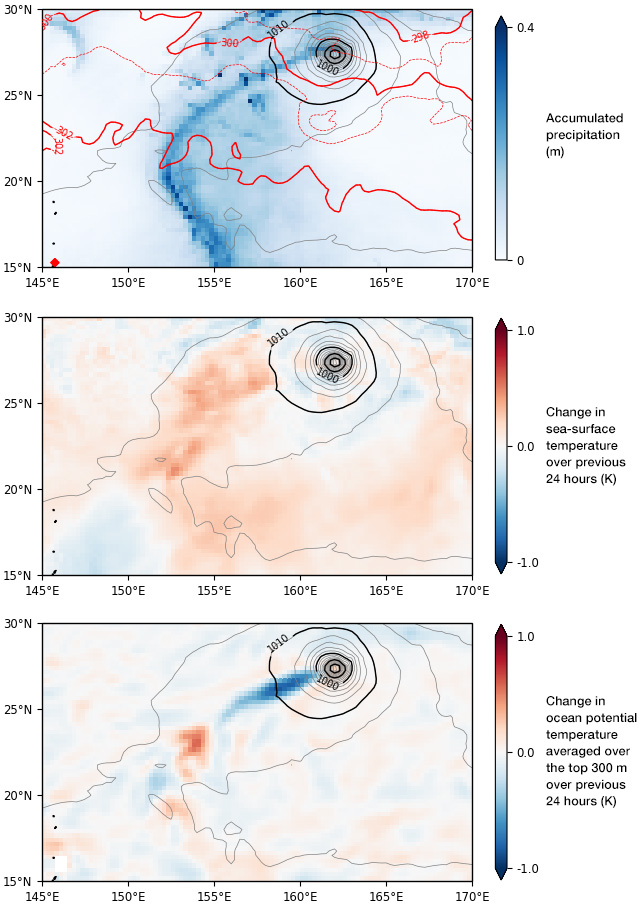

Nine new ocean and sea-ice variables have been added to a multi-model sub-seasonal to seasonal (S2S) weather prediction database hosted by ECMWF.
“The new variables will help researchers to explore the predictability of ocean and sea-ice conditions and to compare the representation of air–ocean–sea-ice interactions in different models,” says ECMWF scientist Frédéric Vitart.
The S2S database was launched in 2015 and is attracting a growing number of scientists working in this field. It includes ensemble forecasts three weeks behind real time and re-forecasts, up to 60 days ahead, from 11 forecasting centres.

The chart shows an example of the kind of data now included in the S2S database: mixed-layer depth, sea-ice thickness, and sensible heat fluxes (red contours, in W/m2) over the ocean from a 45-day ECMWF forecast (the control member of ECMWF’s ensemble forecast, ENS) starting on 2 December 2019. Such data can be used to understand air–ocean–sea-ice interactions.
New variables
In addition to standard atmospheric variables at 10 pressure levels between 1,000 and 10 hPa, the S2S database includes many single-level variables, including thermodynamic, hydrological, and surface flux fields on a 1.5 degrees latitude/longitude grid.
But until recently it contained only two ocean and sea-ice variables: sea-surface temperature and sea-ice cover. Since 1 January 2020, nine new ocean and sea-ice parameters have been added:
- Depth of 20°C isotherm
- Mean sea-level practical salinity in the upper 300 metres
- Mean sea-level potential temperature in the upper 300 metres
- Ocean mixed-layer thickness defined by sigma theta 0.01 kg/m3
- U-component of surface current
- V-component of surface current
- Sea-ice thickness
- Sea-surface height
- Sea-surface practical salinity
“The new variables are archived in GRIB2 format on a 1-degree latitude/longitude grid for daily real-time forecasts and re-forecasts starting on the same date for the last 20 years,” says ECMWF analyst Richard Mladek, who helped to prepare the data for inclusion in the database.
They are currently only available for ECMWF forecasts three weeks behind real time from 1 January 2020, and for corresponding re-forecasts, which are produced on the fly. In the coming weeks, they will become available from three more forecasting centres: ECCC, CMA and CNRM.
Three of the 11 forecasting centres (JMA, ISAC and HMCR) currently produce atmosphere-only S2S forecasts and will therefore not be able to provide the new data. More details on the variables are available on the S2S database web pages.

The new subsurface ocean data can be used to better understand the exchange of energy between the ocean and the atmosphere during the passage of tropical cyclones in S2S forecasts, such as shown here for Typhoon Halong (2019). ECMWF’s 7-day high-resolution forecast (HRES) starting at 00 UTC on 1 November 2019 shows that there was no prominent cold wake in the sea-surface temperature forecast but a clear predicted change in ocean potential temperature averaged over the top 300 metres. Red contours in the top panel show sea-surface temperature (K) and black and grey contours show mean sea-level pressure (hPa).
Resource for scientists
“The S2S database is popular with scientists exploring predictability in the time range between about two weeks and 60 days ahead,” says Manuel Fuentes, Head of Products at ECMWF.
By the end of 2019, 1,371 users had registered to use the database and had extracted 675 terabytes of data. To date, 115 articles based on the S2S database have been published in the peer-reviewed literature.
The S2S database builds on the experience of creating the TIGGE database for medium-range forecasts. It makes available data from the following 11 centres:
- Australian Bureau of Meteorology (BoM)
- China Meteorological Administration (CMA)
- Environment and Climate Change Canada (ECCC)
- European Centre for Medium-Range Weather Forecasts (ECMWF)
- Italy’s Institute of Atmospheric Sciences and Climate of the National Research Council (CNR-ISAC)
- Hydrometeorological Centre of Russia (HMCR)
- Japan Meteorological Agency (JMA)
- Korea Meteorological Administration (KMA)
- Météo-France/Centre National de Recherches Météorologiques (CNRM)
- UK Met Office
- US National Centers for Environmental Prediction (NCEP)
The data is archived at ECMWF and CMA. A large subset is also available from the data library at the US International Research Institute for Climate and Society (IRI, Colombia University).
The S2S database is an outcome of the Subseasonal-to-Seasonal Prediction Project started in 2013 by the World Climate Research Programme and the World Weather Research Programme.
